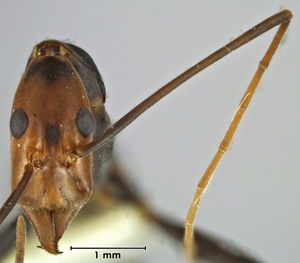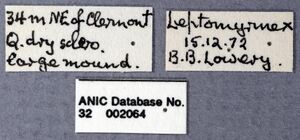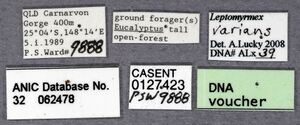Leptomyrmex varians
| Leptomyrmex varians | |
|---|---|

| |
| Leptomyrmex varians | |
| Scientific classification | |
| Kingdom: | Animalia |
| Phylum: | Arthropoda |
| Class: | Insecta |
| Order: | Hymenoptera |
| Family: | Formicidae |
| Subfamily: | Dolichoderinae |
| Tribe: | Leptomyrmecini |
| Genus: | Leptomyrmex |
| Species: | L. varians |
| Binomial name | |
| Leptomyrmex varians Emery, 1895 | |
| Synonyms | |
| |
L. varians has been recorded in dry sclerophyll and Eucalyptus, Casuarina, Melaleuca and Callitris open forests. Nests occur as large or small craters in soil, in the open, or at the base of live trees.
| At a Glance | • Replete Workers |
Identification
L. varians is a distinctly slender and elongate species that occurs in southeastern to central Queensland, from approximately Brisbane to Mackay, in a broad arc that sweeps inland. This species tolerates drier habitat than most other species in the genus. Coloration is usually pale orange with contrasting black legs, including coxae but excluding tarsi, and dark brown antennal scapes and tips. This species may be confused with two other pale-bodied congeners with which it is sympatric in southeast Queensland, Leptomyrmex cnemidatus and Leptomyrmex rufipes. Distinguishing L. varians from these species are the entirely dark coxae, femora and tibiae; in Leptomyrmex cnemidatus the coxae and proximal portion of femora are pale and in L. rufipes the tibiae are pale. Furthermore, the narrowed, but not constricted or projecting posterior margin of the head in L. varians is unlike that in L. cnemidatus (broadly rounded) or L. rufipes (constricted and projecting).
Identification Keys including this Taxon
Distribution
Latitudinal Distribution Pattern
Latitudinal Range: -13.73333° to -30.7°.
| North Temperate |
North Subtropical |
Tropical | South Subtropical |
South Temperate |
- Source: AntMaps
Distribution based on Regional Taxon Lists
Australasian Region: Australia (type locality).
Distribution based on AntMaps
Distribution based on AntWeb specimens
Check data from AntWeb
Countries Occupied
| Number of countries occupied by this species based on AntWiki Regional Taxon Lists. In general, fewer countries occupied indicates a narrower range, while more countries indicates a more widespread species. |

|
Estimated Abundance
| Relative abundance based on number of AntMaps records per species (this species within the purple bar). Fewer records (to the left) indicates a less abundant/encountered species while more records (to the right) indicates more abundant/encountered species. |

|
Biology
Castes
Queens have yet to be collected.
Worker
Images from AntWeb
   
| |
| Worker. Specimen code casent0011997. Photographer Andrea Lucky, uploaded by California Academy of Sciences. | Owned by PSWC, Philip S. Ward Collection. |
Colour variation in L. varians.
       
| |
| . | |
Phylogeny
| Leptomyrmex |
| ||||||||||||||||||||||||||||||||||||||||||||||||||||||||||||||||||||||||||||||||||||||||||||||||||||||||||||||||||||||||||||||||||||||||||
Based on Barden et al., 2017. Note only selected Leptomyrmex species are included.
Nomenclature
The following information is derived from Barry Bolton's Online Catalogue of the Ants of the World.
- varians. Leptomyrmex varians Emery, 1895g: 352, fig. 3 (w.) AUSTRALIA. Senior synonym of angusticeps, decipiens: Lucky & Ward, 2010: 58. See also: Wheeler, W.M. 1934c: 101.
- decipiens. Leptomyrmex erythrocephalus var. decipiens Wheeler, W.M. 1915d: 268 (w.) AUSTRALIA. Wheeler, W.M. 1934c: 90 (m.). Subspecies of erythrocephalus: Wheeler, W.M. 1934c: 90. Junior synonym of varianss: Lucky & Ward, 2010: 58.
- angusticeps. Leptomyrmex varians st. angusticeps Santschi, 1929f: 93, fig. 3 (m.) AUSTRALIA. Junior synonym of varians: Lucky & Ward, 2010: 58.
Type Material
- Leptomyrmex varians: Syntype, 1 worker, Rockhampton, Queensland, Australia, Museo Civico di Storia Naturale, Genoa.
- Leptomyrmex varians: Syntype, 3 workers (reported as males), Byfield (as Beyfield), Queensland, Australia, Naturhistorisches Museum, Basel.
- Leptomyrmex erythrocephalus decipiens: Syntype, 6 workers, Gin-Gin, Queensland, Australia, Museum of Comparative Zoology.
- Leptomyrmex erythrocephalus decipiens: Syntype, 3 workers, Gin-Gin, Queensland, Australia, National Museum of Natural History.
Unless otherwise noted the text for the remainder of this section is reported from the publication that includes the original description.
Description
Worker
Lucky and Ward (2010) - HL 1.92–2.18, HW 1.04–1.19, MFC 0.22–0.28, IOD 0.61–0.70, SL 3.89–4.28, EL 0.36–0.43, WL 3.78–4.29, PW 1.01–1.18, DPW 0.37–0.52, HTL 4.77–5.53, HTWmin 0.13–0.16, HTWmax 0.20–0.31, CI 0.53–0.59, SI 3.31–3.82, OI 0.10–0.15, HTC 0.44–0.64.
Medium sized species (HL 1.92–2.18; HW 1.04–1.19) with a distinctly narrow head (CI 0.53–0.59) excluding mandibles, nearly twice as long as broad. Head widest at eyes, sides of head nearly straight and parallel, posterior to eyes narrowing with straight sides toward posterior margin, forming a slightly constricted ‘neck’. Masticatory margin of mandible with approximately 25 small teeth mostly of uniform size, with larger teeth confined to anterior half. Anterior clypeal margin weakly convex. Eyes positioned approximately at midline of head, small, convex, hairless, surpassing margins of head. Antennal scapes very slender and terete, extending beyond posterior margin by nearly 2/3 of their length.
Pronotum slightly more than 1.5 times as long as broad. Declivity of propodeum very convex, about half the length of the dorsal face, which is flat to weakly concave in profile. Petiolar node triangular in profile with faint longitudinal impression on dorsal face of petiole. Posterior face of petiole longer than anterior face, angle rounded, ventral surface concave. Gaster narrow, elliptical. Legs very slender, tibiae mildly compressed.
Surface subopaque, very finely shagreened. Mandibles with a row of coarse punctures along apical border. Pubescence whitish, extremely short and fine hairs on mandibles and clypeus feebly developed. Long, coarse black hairs on venter sparse. Generally, head, thorax and antennae rufotestaceous, with antennal scapes and tips of mandibles dark brown, and with legs, including coxae, black. Tarsi yellow. Gaster, pronotum and sometimes a spot on the mesonotum black. Some series, however, are brownish-black, with a slight bluish sheen, and only the antennae, tarsi and anterior third of head are lighter (e.g. specimens from Isla Gorge NP, 50km N Taroom and White Mountains NP).
Male
Lucky and Ward (2010) – measurements (n = 4) HL 1.53–1.58, HW 1.12–1.16, SL 0.34–0.37, EL 0.55–0.61, HTL 4.22–4.71, CI 0.72–0.75, SI 0.30–0.32, SI2 1.01–1.11.
References
- Emery, C. 1895h. Descriptions de quelques fourmis nouvelles d'Australie. Ann. Soc. Entomol. Belg. 39: 345-358 (page 352, fig. 3 worker described)
- Lucky, A. 2011. Molecular phylogeny and biogeography of the spider ants, genus Leptomyrmex Mayr (Hymenoptera: Formicidae). Molecular Phylogenetics and Evolution 59: 281-292. doi:10.1016/j.ympev.2011.03.004
- Lucky, A. & Ward, P.S. 2010. Taxonomic revision of the ant genus Leptomyrmex Mayr. Zootaxa 2688: 1-67. PDF
- Wheeler, W. M. 1934c. A second revision of the ants of the genus Leptomyrmex Mayr. Bulletin of the Museum of Comparative Zoology 77: 69-118 (page 101, see also)
References based on Global Ant Biodiversity Informatics
- Baroni Urbani C. 1977. Katalog der Typen von Formicidae (Hymenoptera) der Sammlung des Naturhistorischen Museums Basel (2. Teil). Mitt. Entomol. Ges. Basel (n.s.) 27: 61-102.
- Lucky A., and P. S. Ward. 2010. Taxonomic revision of the ant genus Leptomyrmex Mayr (Hymenoptera: Formicidae). Zootaxa 2688: 1-67.
- Shattuck S. O. 1994. Taxonomic catalog of the ant subfamilies Aneuretinae and Dolichoderinae (Hymenoptera: Formicidae). University of California Publications in Entomology 112: i-xix, 1-241.
- Taylor R. W. 1987. A checklist of the ants of Australia, New Caledonia and New Zealand (Hymenoptera: Formicidae). CSIRO (Commonwealth Scientific and Industrial Research Organization) Division of Entomology Report 41: 1-92.
- Wheeler W. M. 1934. A second revision of the ants of the genus Leptomyrmex Mayr. Bulletin of the Museum of Comparative Zoology 77: 69-118.

